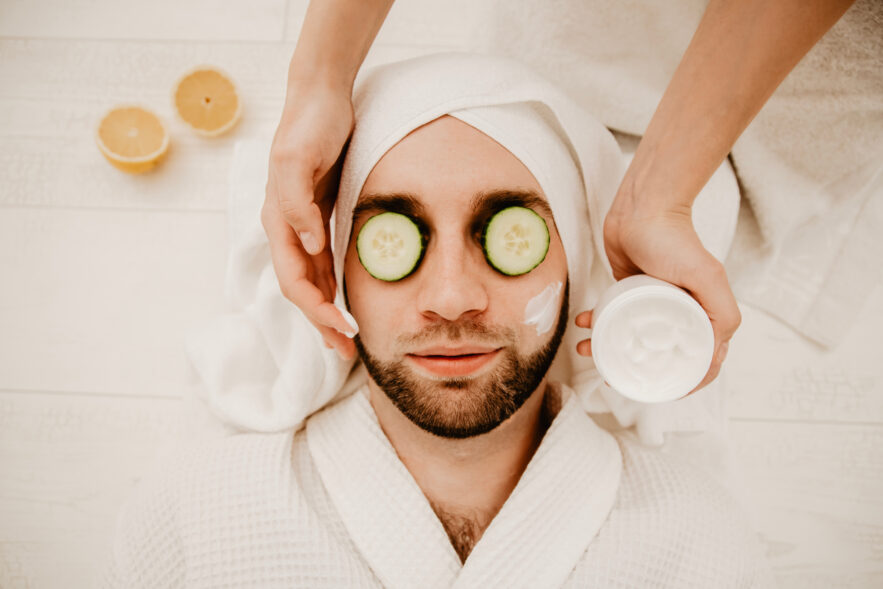By now, most MedShadow readers already know that food has medicinal properties. We often focus on what foods you can eat to improve your condition. But, did you know that some medicinal foods work outside the body? You don’t have to consume these edible cures, but instead can apply them to your skin or hair.
Before you reach for that over-the-counter or even prescription medication, which may result in unwanted side effects, consider a few home remedies that can cure your ailment with less risk.
1. Garlic for a Bee Sting
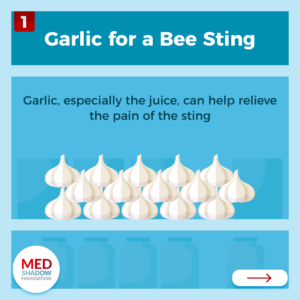
Matthew M. Stevens, a retired criminal judge, said that when he got stung 17 times he was desperate for relief.
“Garlic, especially the juice, can help relieve the pain of the sting,” he says.
But, after personal experience, he felt there was another food option that may work best.
“The two best things you can put on a sting immediately after are alkaloids like ammonia or vinegar,” he says. “They neutralize the acidity of the bee or wasp venom.”
Garlic has antimicrobial and antiinflammatory properties that may help reduce pain and infections after a bee sting. However, in some cases garlic has been known to cause burns on the skin. Monitor the area and rinse the garlic away if you notice any redness or irritation.
2. Epsom Salt to Soothe Muscle Pain
You may not eat this variety of salt, but there are salts said to help muscle pain. Epsom salt is commonly used in a hot bath to reduce aches and pains. How can salts help to heal you?
Studies show that salts, like Epsom, break down in water. In this process, magnesium and sulfate are released. Studies clearly show that magnesium has its benefits treating everything from depression to body aches. However, there has been limited research if the element is absorbed through the skin during treatment such as a bath.
Despite the lack of research, many say that such soaks can go a long way toward feeling better.
“I want to share my personal experience, especially about improving my immunity, muscle health, and stress reduction,” says Dr. Mehmet Yildiz. “Discovering the use of Epsom salts to use in my baths made a positive difference in my physical sensations. Epsom salts helped relax my muscles, especially after a workout or a stressful situation.”
Yildiz says that he adds a few cups of Epsom salts to his bath each night.
“The main benefit I experienced was reducing muscle pain substantially,” he says. “Having a bath with Epsom salts also helped me improve my sleep quality by reducing stress.”
Minimally, the mental health benefits of a warm bath can be enough to improve mood to make it worth a try! Those with broken skin may find the bath irritating to the affected area. Epsom salt baths have also been shown to have some side effects, such as itchy, dry skin, skin infections, or allergic reaction.
3. Peppers for Pain Relief
“Peppers are great for pain relief, says Medshadow Medical Advisory Board Member Alison Acerra, who knows a thing or two about food as medicine.
Acerra, MS, RDN, recommends foods to “Eat and Delete” from your diet to assist your condition each month on MedShadow’s website. From anti-inflammatory diet plans, to recipes to combat Parkinson’s disease, Acerra helps to direct people on how the foods you eat greatly impact the symptoms of your medical conditions.
But, it doesn’t stop there. Not all foods have to be eaten to benefit the body. For example, Acerra says that peppers can be a great topical cure for pain. Scientific studies agree.
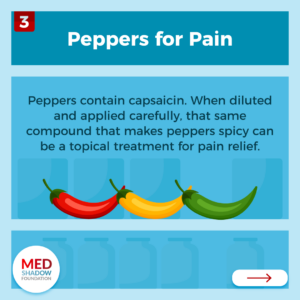
Peppers contain a compound called “capsaicin.” This is the component of peppers, such as chili peppers, which ironically causes some “spicy” pain and irritation when eaten (or even when touched, as those of us who have touched the insides of one too many jalapeno peppers can attest). However, when diluted and applied carefully, that same compound makes peppers a topical treatment for pain relief. One study showed that a patch containing capsaicin decreased pain caused by postherpetic neuralgia, nerve pain that feels like blisters that lingers after shingles fades, pain when administered in proper dosages.
While the study above uses a patch, homemade concoctions may also relieve pain. Mixing three tablespoons of cayenne pepper with one cup of oil (typically olive, jojoba, almond, or grapeseed) combined over a double-boiler can make a soothing cream. Once your oil is warmed, add in white beeswax beads (about half a cup) and mix until melted and absorbed. Store the mix into a tightly sealed glass jar.
“Because of its chemical structure, capsaicin can be well absorbed when administered topically or orally, reaching up to 94% of absorption,” says a 2016 review on capsaicin’s potential medicinal properties.
It’s not yet clear how capsaicin helps relieve pain, but some people believe that mild irritation caused by the spicy pepper causes mild irritation may help distract from your original source of pain. (
4. Beta Carotene for Sun Burn
There may be a good reason that Bugs Bunny rarely had a sunburn. Studies have shown that beta carotene (a compound commonly found in carrots, as well as other yellow, orange, and red fruits and vegetables) can actually reduce your risk of sunburn when applied topically. Ironically, too much consumption of beta carotene can turn you orange, but it won’t be from skin damage caused by UV rays.

One study found that topical preparations with five percent beta carotene solution applied 15 minutes before exposure to UV radiation reduces impact of the sun by 50 percent. A review noted that both consumption of the foods rich in beta carotene and topical ointments containing the compound helped to reduce sunburn risk. Topical ointments are sold over-the-counter with beta carotene already added. However, there are also formulas you can make on your own for eye serum or skin care.
While the beta-carotene infused products benefited participants in some studies, you should always opt for sunscreen or long-sleeves before you get a sunburn. Staying in the shade and protecting your skin from sun damage as much as possible can go a long way to preventing sunburns before they happen.
5. Tea Bags, Cucumbers for Eyes
While there has not been definitive research proving the fact, many swear by the use of tea bags for ailments of the eye. Warm bags are recommended for a compress to alleviate everything from dark circles to eye infections. At best, some anecdotal evidence shows that it may be helpful, though it is likely the warmth of the bags that assists in the reduction of inflammation.
While also short on scientific research, there have been anecdotal reports that the use of cucumber can also have antiinflammatory properties when slices are placed on closed eyes. While often pictured in “spa” scenes, doctors suggest it may be the cool (assuming you’ve refrigerated your cukes) feeling that provides a placebo effect, if nothing more. Either way, there is minimal risk and a chance, for one reason or another, the cool vegetable will reduce puffiness.
6. Oatmeal for Heat Rash
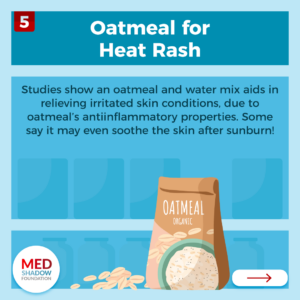
There may be a number of ways to combat heat rash, but one of the best concoctions comes courtesy of medicinal foods. Oatmeal mixed with water can help to cool rashes brought on by heat.
Studies have shown that such mixtures can also aid in relieving irritated skin conditions, due to oatmeal’s antiinflammatory properties. While some products (such as Aveeno) contain oatmeal, the food can be used to increase skin’s moisture on its own.
One 2018 review explained that the antioxidant and antiinflammatory effects of colloidal oatmeal are derived from a plant chemical called “avenanthramides.” Some say oatmeal may also soothe the skin after a sunburn.
For preparation, some recommend a cup of steel-cut, organic oatmeal mixed with warm water. Mix the oats in a bowl until a paste is created, and apply it to the skin. Allow the paste to dry before removing with warm water.
7. Aloe for Burns
Some may consume the yellow skin layer of the aloe plant (the space between the inner “meat” of the leaf and its shell) for constipation. Others eat the inner gel for its antioxidant properties and to add countless vitamins to your diet.
My grandmother always had aloe plants around, when I was a child, but they weren’t for eating. Instead, they were on standby for any minor scrapes or burns. Her children, and now grown grandchildren, continue the tradition in each of our homes; many of us even use clippings from her original plants!
It turns out, Gram may have had something there. Aloe has been shown to help heal burns, for example. In the study, second degree burns that were treated with aloe healed in only 16 days, whereas burns treated with silver sulfadiazine, an antibiotic cream often used to prevent and treat infections in burns, took 19 days to heal.
8. Honey for Pimples
Another MedShadow Foundation Staffer, Garnell Bradley, said that he has had a tried and true method for reducing acne breakouts: honey!
“I suggest honey and a Band-Aid for overnight pimple reduction,” says Bradley. “It’s worked for me since high school.”
The antibacterial properties of honey have been used for centuries. More recent studies revealed that honey can prevent the overgrowth of microbes that contribute to acne. It can also help treat and prevent wound infections.
Bradley suggested placing the honey under a bandage overnight. Others online advise that you place a quarter-sized amount of honey on the fingers, applying directly to the affected area. Leave this in place for 20 minutes, and then rinse with warm water.
9. Almond Flour, Sugar to Exfoliate
The beauty industry isn’t exactly lacking in products to exfoliate, or remove dead skin cells, from your skin. However, a much safer (and cheaper!) alternative to abrasive chemicals may be mixing a scrub up in your own kitchen. Simply adding water to ingredients such as almond flour or even basic sugar can make a great exfoliant that gently sloughs off your dead skin cells.
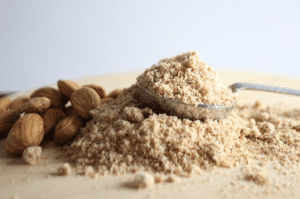
A basic sugar scrub can be made with one cup of sugar mixed with a half cup of coconut oil. For a great scent, you can opt to add lemon, lime, orange, or grapefruit juice or zest. Alternatively, a few drops of vanilla extract can create a cookie-like aroma.
For almond paste face masks, simply add warm water to a half cup of almond flour until the mixture is a thick paste. Apply to the face, and rinse with warm water after 10 to 20 minutes.
10. Yogurt for Facial Cleansing
Like most systems in our bodies, your skin has a unique balance of good and bad bacteria. When you wash your face, it is with the goal of removing “bad” bacteria without destroying the natural balance of your skin.
Some studies suggest that the use of plain yogurt may help. Not only does yogurt have a high protein content, great for your skin’s elasticity, but it also contains probiotics, often called “healthy bacteria” that can balance your skin’s chemistry. Probiotics help with immune regulation, acne, and even sun damage when applied to the skin. Such probiotics can be found in OTC creams or in plain, edible yogurt.
11. Coffee for Cellulite
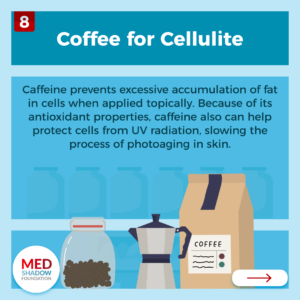
Not only have some skin experts recommended coffee grounds as a great exfoliator, but it has also been studied to reduce cellulite.
“Coffee scrubs are scrubs that use coffee granules or finely ground coffee particles to help exfoliate the skin and remove dead cells,” Dr. Marisa Garshick, MD, a board-certified dermatologist in New York City, tells Byrdie.
A 2012 review noted that the use of caffeine in cosmetic products has benefits for the body. Caffeine prevents excessive accumulation of fat in cells when applied topically. Because of its antioxidant properties, caffeine also can help protect cells from UV radiation, slowing the process of photoaging in skin.
In some cases, coffee has also been shown to increase microcirculation of the blood in the skin, as well as stimulate hair growth. If ground coffee beans on your skin isn’t your first choice for this expensive ingredient, cosmetic products containing at least three percent caffeine can be purchased over the counter.
If you prefer to make one at home, coffee grounds, with added sea salt and a bit of coconut oil can make a great body scrub to both exfoliate and reduce cellulite.
12. Onions for Scars
While old wive’s tales may advise you to place raw onion on your feet for the common cold or flu symptoms, there is no scientific evidence that this actually helps. However, there is evidence that the root vegetable can help reduce scarring formed during wound healing.
Quercetin, a compound found in onions and their extracts, has been shown to benefit scar treatment. A 2017 study on mice, showed the compound’s application to scar tissue helped the body to create healthier skin as it heals. The study did note that further research would need to be done to review if the same proves true in humans.
A 2018 study followed patients after surgical procedures. The study compared the use of a topical application of onion extract against one composed of a silicon gel, a common scar treatment. After applying the treatments for 12 weeks, researchers found both were equally as effective for treating the postsurgical scars.
Scientists conducted a similar study in 2012 to test the use of onions in scar repair. Daily application of onion extract gel was compared against no treatment at all. The study included 42 participants and lasted for 10 weeks, but researchers pointed out that those who got the onion extract gel saw improvements in scar appearance as early as four weeks into the study.
A simple onion extract gel can be made right in your own kitchen by juicing an onion (approximately one teaspoon of juice) with a tablespoon of pure aloe vera. Place the gel onto a scar, topically, and leave on for around 10 minutes. Rinse with warm water.
13. Olive Oil for Moisturizer
Entire cultures use the commonly found extra virgin olive oil (EVOO) as a skin and hair moisturizer. For example, one study found that 88.7 percent of Saudi women had used topical olive oil for skin and/or hair care. The food item has antioxidants, not to mention antibacterial and antiinflammatory qualities. But, does it work?
One study found that olive oil showed promise as a wound-healing agent. The same study, however, noted that more research would be needed to identify its benefits before the oil could be used as a treatment for wounds in humans.
Wounds aside, many turn to this common pantry item for its moisturizing benefits.
MedShadow’s SEO and Site Manager, Max Cherenfant, says he often turns to the product for softer skin.
“I recommend using it right out of the shower,” he says. “I’ve used it for quite some time.”
However, others have had side effects when using EVOO on their skin. The oil can be heavy and greasy, leaving a “slime-like” coating on the skin. Additionally, it can cause clogged pores, acne breakouts, and increase the appearance of blackheads due to its greasy nature.
MedShadow Staff Writer Emma Yasinski says her skin broke out and appeared quite red after use.
“I just got a lot of splotches, redness,” she says. Additional side effects can include a rash or skin irritation. When testing EVOO (or other topical skin products), it is best to test on a small portion of the skin to see its impact before applying to larger areas.
Weighing Your Options to Reduce Side Effects
Overall, the use of foods as topical treatments does not come with many side effects. Users may experience irritation or reaction at the application site. Do not use the foods if you are allergic to it or any of its compounds.
On the flip side, skin medications such as topical corticosteroids come with a lengthy list of potential side effects. Some side effects of steroid topical creams or gels include:
- Worsening of the initial infection
- Inflamed hair follicles (folliculitis)
- A thinning of the skin
- Scarring, discoloring, or redness
- Allergic reaction
- Acne or breakouts in the area of application
- Rosacea (reddening of the face)
- Excessive hair growth
- Skin atrophy
- Premature aging of the skin
- Rebound effect
- Bruising more easily
- Diminished responsiveness with repeat doses
Homemade remedies reduce your exposure to chemicals and drugs. They are often more affordable. They have fewer dangerous side effects. For some, they may be a better option.
No product, food, chemical, nor pharmaceutically-produced ointment, is without impact. All treatments have side effects. Many foods can irritate the skin, causing a rash or irritation. Test any new treatment on a small area of skin to note any reaction prior to any use.
As always, you should also speak to your healthcare professionals if you have any worrying conditions or skin ailments. Talk to your healthcare provider about any concerns you have about your medicines, and ask for options in your care. Sometimes, that newest trendy drug isn’t the answer, and instead, you can find helpful aids right in your own kitchen pantry.
MedShadow Foundation does not provide medical advice, diagnosis, or treatment.


